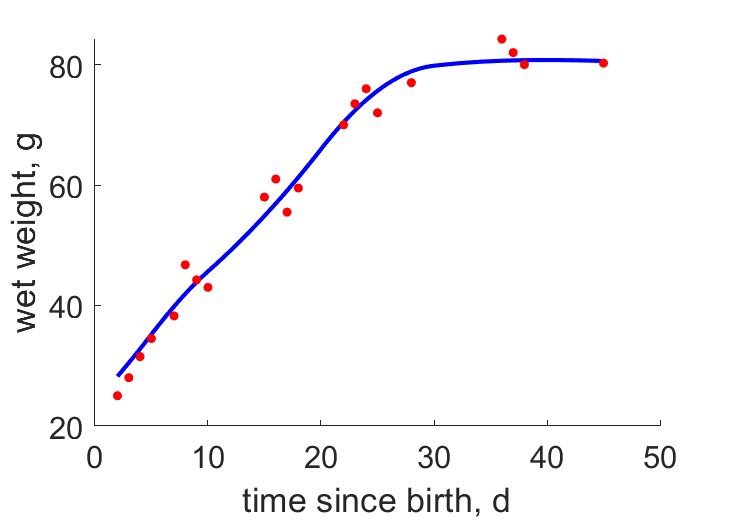Predictions & Data for this entry
| Model: std | climate: A | migrate: | phylum: |
| COMPLETE = 2.5 | ecozone: TN | food: biCi | class: |
| MRE = 0.037 | habitat: 0iTh, 0iTf, 0iTi | gender: Dg | order: |
| SMSE = 0.003 | embryo: Tnpfm | reprod: O | family: |
Zero-variate data
| Data | Observed | Predicted | (RE) | Unit | Description | Reference |
|---|---|---|---|---|---|---|
| ab | 31.5 | 33.36 | (0.05906) | d | age at birth | avibase |
| tx | 43.5 | 43.52 | (0.0005112) | d | time since birth at fledging | avibase |
| tp | 130.5 | 119 | (0.08832) | d | time since birth at puberty | guess |
| tR | 640 | 640 | ( 0) | d | time since birth at 1st brood | guess |
| am | 1.46e+04 | 1.465e+04 | (0.003111) | d | life span | guess |
| Ww0 | 29.25 | 27.29 | (0.06699) | g | initial egg weight | avibase |
| Wwi | 180 | 195.2 | (0.08425) | g | ultimate wet weight for females | avibase |
| Wwim | 242 | 241.3 | (0.003076) | g | ultimate wet weight for males | avibase |
| Ri | 0.00274 | 0.002648 | (0.03362) | #/d | maximum reprod rate | avibase |
Uni- and bivariate data
| Data | Figure | Independent variable | Dependent variable | (RE) | Reference |
|---|---|---|---|---|---|
| tW |  | time since birth | wet weight | (0.03653) | SancYust2016 |
Pseudo-data at Tref = 20°C
| Data | Generalised animal | Nyctibius griseus | Unit | Description |
|---|---|---|---|---|
| v | 0.02 | 0.02348 | cm/d | energy conductance |
| p_M | 18 | 692.6 | J/d.cm^3 | vol-spec som maint |
| k_J | 0.002 | 0.02914 | 1/d | maturity maint rate coefficient |
| k | 0.3 | 0.3073 | - | maintenance ratio |
| kap | 0.8 | 0.957 | - | allocation fraction to soma |
| kap_G | 0.8 | 0.8021 | - | growth efficiency |
| kap_R | 0.95 | 0.95 | - | reproduction efficiency |
Discussion
- Males are assumed to differ from females by {p_Am} only
- mod_1: Pseudo-data point k is used, rather than k_J; Data set tp and parameter t_R are added, the latter replacing clutch interval t_N. Postnatal T is based on PrinPres1991, see get_T_Aves. See further the revision page, theme puberty
Bibliography